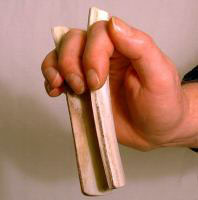Bones (instrument)

A pair of bones in playing position.
|
|
| Percussion instrument | |
|---|---|
| Other names | bones |
| Classification | |
| Hornbostel–Sachs classification | 111.11 (Concussion sticks or stick clappers) |
| Related instruments | |
The bones are a musical instrument (more specifically, a folk instrument) which, at the simplest, consists of a pair of animal bones, or pieces of wood or a similar material. Sections of large rib bones and lower leg bones are the most commonly used true bones, although wooden sticks shaped like the earlier true bones are now more often used. If metal spoons are used instead, as is common in the United States, this is called "playing the spoons". The technique probably arrived in the U.S. via Irish and other European immigrants, and has a history stretching back to ancient China, Egypt, Greece, and Rome.
They have contributed to many music genres, including 19th century minstrel shows, traditional Irish music, the blues, bluegrass, zydeco, French-Canadian music, and music from Cape Breton in Nova Scotia. The clacking of the loose rib bones produces a much sharper sound than the zydeco washboard or frottoir, which mimics rattling a bone up and down a fixed ribcage.
They are typically about 5" to 7" in length, but can be much longer, and they are often curved, roughly resembling miniature barrel staves. Bones can also be flat, for example by the cutting of a yardstick. They are played by holding them between one's fingers, convex surfaces facing one another, and moving one's wrist in such a way that they knock against each other. One method involves placing the bones to either side of the middle finger such that approximately two-thirds of their length extends along the palm while the remainder protrudes above the fingers on the backside of the hand. The hand is held in a loose fist with the bones and the curled fingers roughly parallel to the palm, with the bone closest to the ring finger gently held against the palm by the tip of the ring finger placed on its edge, while the other bone is left free to move in the "hinge" formed by the index and middle fingers as they gently hold it. It is also possible to play the "hinge" on the lower (ring finger) bone while locking the top (index finger) bone against the palm.
...
Wikipedia
